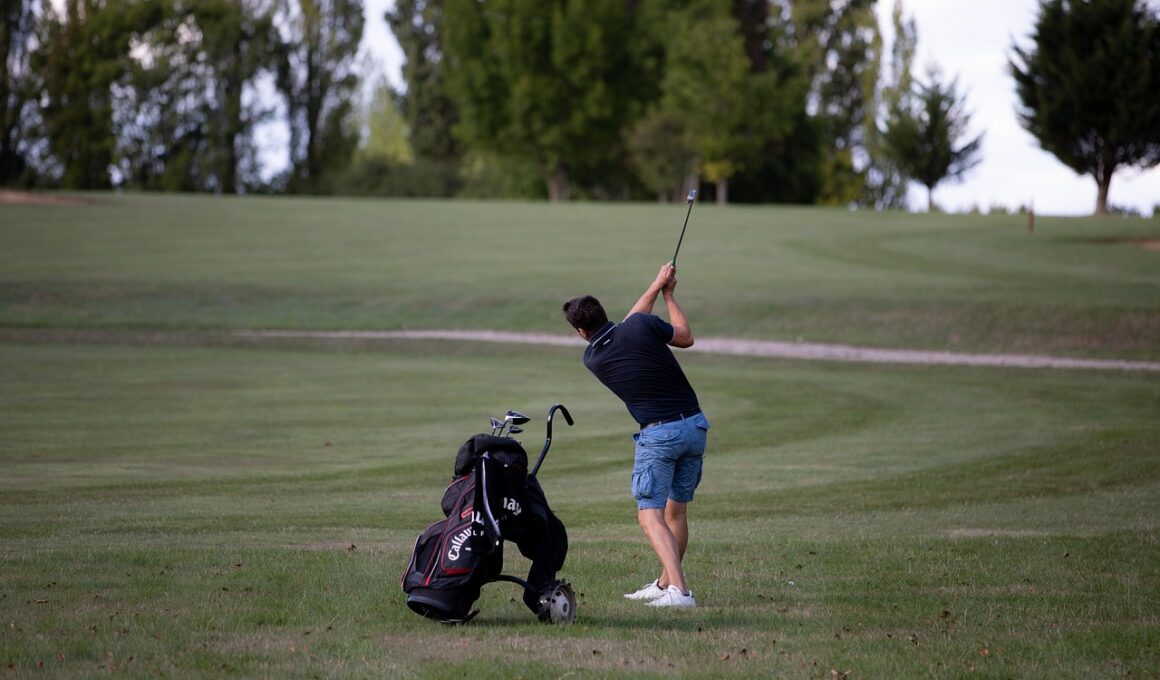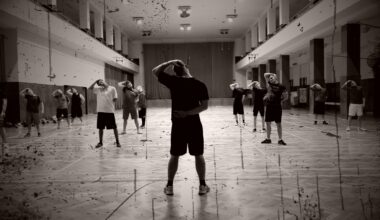Golf Injury Rehab: Understanding Muscle Imbalances and Corrective Exercises
Golf injuries often stem from muscle imbalances, which can significantly affect performance and lead to chronic pain. These imbalances develop due to repetitive swinging motions and poor body mechanics. Understanding your body is crucial in customizing a rehabilitation approach. For instance, back pain is a common condition among golfers, frequently resulting from tight hip flexors and weak glute muscles. Therefore, rehabilitative exercises should aim to strengthen weak muscles while stretching the tight ones. Incorporating targeted exercises into a rehab program helps restore balance and prevents future injuries. It’s essential to consult with a golf fitness specialist and a physical therapist who can assess your specific needs. They will provide personalized exercise recommendations, ensuring you address the exact imbalances affecting your game. A solid understanding of anatomy and biomechanics is vital for selecting the right exercises. This knowledge can lead to significant improvements in mobility, flexibility, and overall performance. Ultimately, tackling muscle imbalances effectively can enhance longevity in your golfing career and improve enjoyment and success on the course. Rehabilitation will prepare you for your next game, enhancing your confidence as you resume play after an injury.
A crucial aspect of golf injury rehabilitation is the implementation of corrective exercises that target specific imbalances. Within the rehabilitation phase, a variety of exercises can be employed to enhance strength and flexibility. These recommendations often include resistance training, core stabilization, and stretching techniques to balance muscle groups. For example, strengthening the core can stabilize the pelvis and improve swing mechanics. Effective exercises typically involve the following:
- Rotational exercises that mimic the golf swing.
- Stretching routines focusing on hip and shoulder mobility.
- Balance training to enhance coordination while swinging.
- Resistance bands for functional strength development.
Including these exercises in your regimen is essential for fully addressing muscular imbalances. Furthermore, utilizing foam rollers or massage therapy can assist in alleviating muscle tightness and improve circulation. Having a dedicated routine ensures that you rehabilitate effectively, optimizing your overall golf performance. Always adapt your program to align with personal progress and fitness levels, as each individual’s rehabilitation journey is unique. Tracking improvements can motivate you to stay committed to the rehabilitation process.
The Importance of Mobility in Golf
Mobility plays a pivotal role in optimizing a golfer’s performance on the course. Having adequate mobility directly impacts swing mechanics, allowing for a complete and powerful swing. Inadequate mobility can lead to compensatory movements, often resulting in injury and inconsistency. Therefore, injury rehabilitation must include a focus on improving neck, shoulder, hip, and ankle mobility. Regular stretching, dynamic warm-ups, and mobility drills contribute significantly to enhancing flexibility. Furthermore, investing in mobility work not only aids rehabilitation but also serves as a preventative measure. Incorporating exercises such as hip openers and thoracic spine rotations helps maintain a robust range of motion during gameplay. Practicing yoga can complement this process, as it emphasizes breath control and enhances overall body awareness. Not only can improved mobility boost swing power and accuracy, but it also fosters overall body health. By adopting regular mobility drills into your routine, you’re investing in your future golfing performance. Remember to assess your individual mobility limitations and tailor drills to address them. This proactive approach subsequently combats injury and sustains performance, keeping you healthy for years of enjoyable golfing.
Specific injury types commonly encountered in golf include low back pain, shoulder injuries, and elbow issues. Each of these injuries often stems from poor biomechanics or muscular imbalances, necessitating targeted rehabilitation strategies. For example, low back pain is frequently linked to weakness in the core and glutes or tightness in hip flexors. Implementing stretches for these areas, along with strengthening exercises, proves crucial in the rehab process. Shoulder injuries often result from a lack of scapular stabilization and rotator cuff weakness, necessitating exercises to enhance shoulder integrity and function. Additionally, golfer’s elbow, caused by repetitive elbow motion, requires a balanced approach targeting the forearm muscles and enhancing wrist strength flexibility. Engaging a golf fitness professional can help establish a personalized routine, focusing on your specific needs. Understanding these common injuries allows for better preparation and prevention, setting you up for a successful recovery. Engaging in injury prevention strategies such as proper warm-ups, technique analysis, and strengthening will also safeguard against future ailments. By maintaining awareness of your physical state, it’s easier to pinpoint weaknesses before they develop into significant issues.
Creating a Personalized Rehab Plan
Creating a personalized rehabilitation plan provides clarity and focus during the recovery process. This individualized approach ensures that every aspect of your injury is adequately addressed. Begin by undergoing a thorough assessment by a qualified professional, which can include functional movement screenings and physical evaluations. These assessments will help to determine specific areas needing attention, enabling you to clarify your exercise goals. Essential to the rehabilitation plan is not just exercise selection but establishing appropriate timelines for recovery based on specific injuries or conditions. It’s crucial that the plan evolves with your progress, incorporating gradually challenging movements as your strength returns. Consistency is vital in following through with your rehabilitation protocol, committing to the prescribed exercises at least three times weekly. Remember to monitor your progress regularly, as it helps to adjust the plan as needed. Tracking improvements can also provide an additional motivational boost, helping you remain consistent in your rehab efforts. Mental fortitude is often just as essential as physical rehabilitation, as belief in the healing process leads to successful outcomes. In the end, your rehabilitation journey not only heals injuries but also improves performance.
Incorporating wellness aspects into your rehabilitation can enhance overall recovery and performance. Nutrition, hydration, and mental well-being are significant components that should never be overlooked during the rehab process. Ensuring a balanced diet rich in vitamins, minerals, and proteins can significantly expedite healing time. Staying hydrated contributes to optimal muscle function and recovery, facilitating performance gains. Moreover, adopting strategies such as mindfulness meditation and visualization can reinforce mental focus and resilience during rehabilitation. Engaging in relaxation techniques plays an important role in reducing stress and anxiety levels, promoting a conducive environment for healing. Be sure to get adequate rest to allow your body time to recover effectively. Recovery isn’t just about physical strength but encompasses mental and emotional well-being. Consequently, spending time outdoors or engaging in light activities can elevate mood and foster positivity throughout the rehabilitation process. Creating a maintainable routine that incorporates these wellness metrics can ultimately lead to more profound success in your golf fitness journey. Prioritizing both physical and psychological aspects paves the way not just for injury rehab but also for a healthier lifestyle.
Final Thoughts on Golf Injury Rehab
Understanding muscle imbalances and implementing corrective exercises serves as a foundation for effective golf injury rehabilitation. As enhancing performance is often a primary concern for golfers, comprehending how to address underlying injury causes can ensure longevity in the sport. Committing to a personalized rehabilitation plan and incorporating specific exercises tailored to individual needs will significantly hasten recovery. Furthermore, focusing on mobility, strength, and overall wellness facilitates a more balanced approach toward rehabilitation. The impact of maintaining these efforts cannot be emphasized enough; those who invest time in their recovery not only heal faster but also improve overall performance on the golf course. Prevention strategies should be adhered to as well in order to reduce the likelihood of future injuries. By nurturing both physical and mental health, individuals can cultivate a more enjoyable and fulfilling golf experience. It’s essential to remain patient with the rehabilitation process, acknowledging that each person’s recovery journey is unique. Ultimately, injury rehabilitation is about more than just healing; it is about becoming a stronger and more resilient golfer ready to face challenges with confidence. Stay dedicated, and you will reap the rewards on the course.


